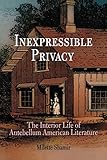Inexpressible Privacy : The Interior Life of Antebellum American Literature / Milette Shamir.
Material type: TextPublisher: Philadelphia : University of Pennsylvania Press, [2013]Copyright date: ©2006Description: 1 online resource (296 p.) : 8 illusContent type:
TextPublisher: Philadelphia : University of Pennsylvania Press, [2013]Copyright date: ©2006Description: 1 online resource (296 p.) : 8 illusContent type: - 9780812220230
- 9780812204247
- 818.409353
- online - DeGruyter
- Issued also in print.
| Item type | Current library | Call number | URL | Status | Notes | Barcode | |
|---|---|---|---|---|---|---|---|
 eBook
eBook
|
Biblioteca "Angelicum" Pont. Univ. S.Tommaso d'Aquino Nuvola online | online - DeGruyter (Browse shelf(Opens below)) | Online access | Not for loan (Accesso limitato) | Accesso per gli utenti autorizzati / Access for authorized users | (dgr)9780812204247 |
Frontmatter -- Contents -- Introduction -- Chapter 1. Divided Plots: Gender Symmetry and the Architecture of Domestic Space -- Chapter 2. Dream Houses: Divided Interiority in Three Antebellum Short Stories -- Chapter 3. The Master's House Divided: Exposure and Concealment in Narratives of Slavery -- Chapter 4. Hawthorne's Romance and the Right to Privacy -- Chapter 5. Thoreau in Suburbia: Walden and the Liberal Myth of Private Manhood -- Chapter 6. "The Manliest Relations to Men": Thoreau on Privacy, Intimacy, and Writing -- Afterword -- Notes -- Bibliography -- Index -- Acknowledgments
restricted access online access with authorization star
http://purl.org/coar/access_right/c_16ec
Selected by Choice magazine as an Outstanding Academic TitleFew concepts are more widely discussed or more passionately invoked in American public culture than that of privacy. What these discussions have lacked, however, is a historically informed sense of privacy's genealogy in U.S. culture. Now, Milette Shamir traces this peculiarly American obsession back to the middle decades of the nineteenth century, when our modern understanding of privacy took hold.Shamir explores how various discourses, as well as changes in the built environment, worked in tandem to seal, regulate, and sanctify private spaces, both domestic and subjective. She offers revelatory readings of texts by Nathaniel Hawthorne, Frederick Douglass, Herman Melville, Harriet Beecher Stowe, Henry David Thoreau, and other, less familiar antebellum writers and looks to a wide array of sources, including architectural blueprints for private homes, legal cases in which a "right to privacy" supplements and exceeds property rights, examples of political rhetoric vaunting the sacred inviolability of personal privacy, and conduct manuals prescribing new codes of behavior to protect against intrusion.
Issued also in print.
Mode of access: Internet via World Wide Web.
In English.
Description based on online resource; title from PDF title page (publisher's Web site, viewed 24. Apr 2022)


